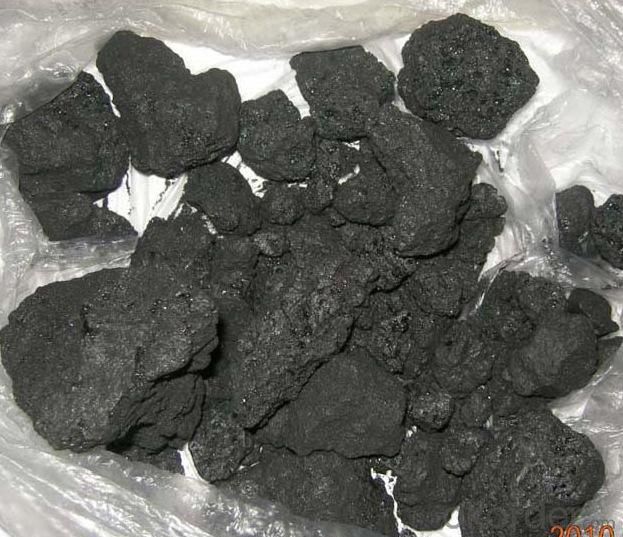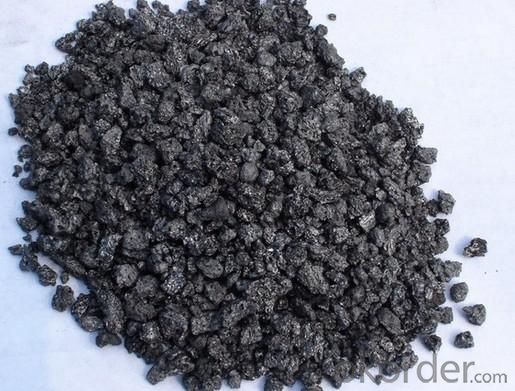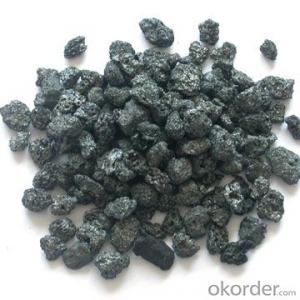Calcined Petroleum Coke Specification of CNBM in China
- Loading Port:
- Tianjin
- Payment Terms:
- TT OR LC
- Min Order Qty:
- 1 m.t.
- Supply Capability:
- 10000000 m.t./month
OKorder Service Pledge
OKorder Financial Service
You Might Also Like
1.Structure of Calcined Petroleum Coke Description
Calcined Petroleum Coke is made from raw petroleum coke,which is calcined in furnace at a high temperature(1200-1300℃).CPC/Calcined Petroleum Coke is widely used in steelmaking,castings manufacture and other metallurgical industry as a kind of recarburizer because of its high fixed carbon content,low sulfur content and high absorb rate.Besides,it is also a best kind of raw materials for producing artifical graphite(GPC/Graphitized Petroleum Coke) under the graphitizing temperature(2800℃).
2.Main Features of the Calcined Petroleum Coke
High-purity graphitized petroleum coke is made from high quality petroleum coke under a temperature of 2,500-3,500°C. As a high-purity carbon material, it has characteristics of high fixed carbon content, low sulfur, low ash, low porosity etc.It can be used as carbon raiser (Recarburizer) to produce high quality steel,cast iron and alloy.It can also be used in plastic and rubber as an additive.
3. Calcined Petroleum Coke Images


4. Calcined Petroleum Coke Specification
Physical Properties:
| Element | Percentage |
| Real Density | 2.06 g/cc |
| Apparent Density | 1.40 g/cc |
| Hard grove grindability index | 33-43 |
Standard Sizes (Granulometry):
0-4 mm, 0.5-3 mm, 0-25 mm, 1-4 mm, 2-8 mm We also supply as per customer's requirement.
Chemical Properties :
Fixed Carbon | Sulphur Content | Moisture | V.Matter | Ash |
98% | 0.6%max | 5%max | 0.7max | 0.5%max |
98.5min | 0.5%max | 5%max | 0.5max | 0.5%max |
5.FAQ of Calcined Petroleum Coke
1). Q: Are you a factory or trading company?
A: We are a factory.
2). Q: Where is your factory located? How can I visit there?
A: Our factory is located in ShanXi, HeNan, China. You are warmly welcomed to visit us!
3). Q: How can I get some samples?
A: Please connect me for samples
4). Q: Can the price be cheaper?
A: Of course, you will be offered a good discount for big amount.
- Q:How do you remove car carbon?
- 3, running high speed can flush carbon deposition? Running high speed, you can really use the airflow on the airway erosion, wash away part of the carbon deposition. So, if you happen to go out, there are high-speed, national road two choices, you may choose to pull back to speed. But, Ma director thinks, if be in order to "flush carbon deposit" specially, want to run high speed, do not have this necessity. "It is a waste of time, and the cost of oil, extra high speed tolls, the effect is better to do a maintenance 4S shop!" 4, improve the shift speed, such as the original speed 2000rpm shift, modified 2500rpm conversion, generated can prevent carbon deposition, but also to protect the engine? Ma director said, low speed the shift, is often said that the "drag block", the car is easy to knock, the combustion of gasoline is not sufficient to carbon deposition. But it's not necessary for people to increase gear speed - that will increase fuel consumption and cause premature wear of clutch friction plates. So, manual transmission of the car, 1.6 ~ 2.0L displacement, about 2000 rpm shift is more economical, and no need to improve; and automatic car, pay attention not to slam the gas.
- Q:How does carbon affect the melting of polar ice caps?
- The connection between carbon and climate change has a direct impact on the melting of polar ice caps. When humans release carbon dioxide, a greenhouse gas primarily emitted through the burning of fossil fuels, it acts as a sort of blanket, trapping heat within the Earth's atmosphere. This trapped heat then leads to a rise in global temperatures, ultimately causing the polar ice caps to melt at an accelerated pace. As carbon dioxide is emitted into the atmosphere, it prevents the Earth's heat from escaping into space, much like a blanket would. Consequently, the overall temperature of the planet increases, resulting in the melting of glaciers and ice sheets in the polar regions. The more carbon dioxide is released, the more heat is trapped, leading to a further rise in global temperatures and a faster rate of ice melting. The consequences of the melting polar ice caps are significant. As the ice continues to melt, it contributes to the rise of sea levels, which poses a threat to coastal communities and ecosystems worldwide. Furthermore, the loss of polar ice diminishes the Earth's ability to reflect sunlight, as ice has a high albedo, or reflectivity. This means that as more ice melts and is replaced by darker ocean water or land, more sunlight is absorbed, further warming the planet and creating a positive feedback loop. Taking steps to reduce carbon emissions and address climate change is crucial in order to mitigate the melting of polar ice caps. Transitioning to renewable energy sources, improving energy efficiency, and implementing sustainable practices are some of the ways in which we can minimize carbon emissions and slow down the rate of ice melting. By taking action on carbon emissions, we can play a role in preserving the polar ice caps and lessening the devastating consequences of climate change.
- Q:How does carbon dioxide affect global warming?
- Carbon dioxide (CO2) is a greenhouse gas that plays a significant role in global warming. When released into the atmosphere, CO2 traps heat from the sun, preventing it from escaping back into space. This process leads to the Earth's temperature increasing, resulting in global warming. The increased levels of CO2, primarily from human activities such as burning fossil fuels, deforestation, and industrial processes, have caused a substantial rise in the Earth's average temperature over the past century. This rise in temperature has led to various adverse effects, including melting ice caps, sea-level rise, extreme weather events, and disruptions to ecosystems. Thus, carbon dioxide is a major contributor to global warming and its associated impacts.
- Q:Which is better, 13 and 14 carbon breath tests?
- Two kinds of carbon synthesis conditions are different, the instruments are not the same, so lead to price differences
- Q:How does carbon impact the availability of clean air?
- Carbon impacts the availability of clean air through its contribution to air pollution and climate change. When carbon-based fuels such as coal, oil, and natural gas are burned for energy production, they release carbon dioxide (CO2) into the atmosphere. CO2 is a greenhouse gas that traps heat in the Earth's atmosphere, causing the planet to warm up, leading to climate change. Climate change, in turn, affects air quality in several ways. Rising temperatures can increase the frequency and intensity of wildfires, which release large amounts of carbon dioxide and other pollutants into the air. Additionally, higher temperatures can exacerbate the formation of ground-level ozone, a harmful air pollutant that can trigger respiratory issues and other health problems. Furthermore, carbon emissions contribute to the formation of particulate matter, such as soot and fine particles, which can be harmful when inhaled. These particles can come from the burning of fossil fuels in vehicles, power plants, and industrial processes. Particulate matter can cause respiratory and cardiovascular problems and is especially harmful to vulnerable populations like children, the elderly, and those with pre-existing respiratory conditions. Reducing carbon emissions is crucial to improving air quality and ensuring the availability of clean air. Transitioning to renewable energy sources, improving energy efficiency, and implementing policies to reduce carbon emissions can all help mitigate the impact of carbon on air quality. Additionally, promoting sustainable transportation, reducing deforestation, and adopting cleaner industrial practices can contribute to cleaner air by reducing carbon emissions and other pollutants.
- Q:What are carbon offsets?
- The use of carbon offsets is a method employed to aid in the reduction of greenhouse gas emissions and the fight against climate change. Essentially, it offers a means for individuals, organizations, or businesses to compensate for their own carbon dioxide (CO2) emissions by investing in projects that decrease emissions in other places. Carbon offsets are founded on the concept that emissions reduction can be accomplished through various methods and at different costs. Rather than solely focusing on reducing their own emissions, individuals or entities can utilize carbon offsetting to support projects that can achieve greater emission reductions per unit of cost. These projects encompass renewable energy, energy efficiency, reforestation, methane capture, and others. To obtain carbon offsets, individuals or organizations typically calculate their own carbon footprint by evaluating the amount of CO2 they emit through activities like energy consumption or transportation. After quantifying their emissions, they can purchase carbon offsets equivalent to the amount of CO2 they have emitted. These offsets are generated by projects that undergo independent verification and certification by recognized standards and registries. Once purchased, the carbon offsets are effectively canceled or retired, ensuring that the emission reduction accomplished by the project is not double-counted or claimed by another party. By investing in carbon offsets, individuals or organizations can effectively neutralize their own emissions and contribute to global endeavors to combat climate change. However, it is crucial to recognize that carbon offsets should not be viewed as a substitute for reducing emissions at the source. They should be utilized as a supplementary tool to support emission reduction efforts while simultaneously implementing measures to minimize our own emissions through energy efficiency, adoption of renewable energy, and sustainable practices.
- Q:How do forests act as carbon sinks?
- Forests act as carbon sinks by absorbing carbon dioxide from the atmosphere through the process of photosynthesis. Trees and other plants take in carbon dioxide and convert it into oxygen, while storing the carbon in their trunks, branches, and roots. This stored carbon remains in the forest ecosystem, reducing the amount of greenhouse gases in the atmosphere and helping to mitigate climate change.
- Q:What is the density of carbon?
- The density of carbon depends on its form. The most common form of carbon is graphite, which has a density of 2.267 grams per cubic centimeter (g/cm³). However, another form of carbon called diamond has a much higher density of 3.515 g/cm³. So, it is important to specify which form of carbon we are referring to when discussing its density.
- Q:What is carbon black rubber?
- Carbon black rubber is a type of rubber that is reinforced with carbon black particles. Carbon black is a fine black powder made from the incomplete combustion of hydrocarbons. It is added to rubber formulations to enhance its strength, durability, and resistance to wear and tear. This type of rubber is commonly used in the manufacturing of tires, conveyor belts, seals, gaskets, and various other rubber products.
- Q:Carbon injection molding machine heating several degrees
- Polycarbonate (PC) is a colorless and transparent engineering plastics, the impact strength is high, the use of a wide temperature range, good creep resistance, electrical insulation and dimensional stability; the disadvantage is sensitive to the gap, environmental stress cracking resistance, with metal insert molding products is difficult.Polycarbonate, English name Polycarbonate, referred to as PC. PC is a kind of amorphous, odorless, non-toxic, highly transparent colorless or slightly yellow thermoplastic engineering plastics, has excellent physical and mechanical properties, especially excellent shock resistance, tensile strength, bending strength, compressive strength and high creep; small size stability; has good heat resistance and low temperature resistance and with mechanical properties, stable in a wide range of temperature dimensional stability, electrical properties and flame retardant properties, can be used for a long time at -60~120 deg.c; no obvious melting point, molten at 220-230 DEG C; because the molecular chain rigidity, resin melt viscosity; low water absorption, low shrinkage, size high precision, good dimensional stability, permeability of films is small; self extinguishing materials; stable to light, but not UV resistance, good weather resistance; oil resistance, acid and alkali resistance, non oxidizing acids and amines, ketones, solution Chlorinated hydrocarbons and aromatic solvents are prone to hydrolysis and cracking in water for a long time. The disadvantage is that they are prone to stress cracking due to poor fatigue resistance, poor solvent resistance and poor wear resistance.
1. Manufacturer Overview |
|
|---|---|
| Location | |
| Year Established | |
| Annual Output Value | |
| Main Markets | |
| Company Certifications | |
2. Manufacturer Certificates |
|
|---|---|
| a) Certification Name | |
| Range | |
| Reference | |
| Validity Period | |
3. Manufacturer Capability |
|
|---|---|
| a)Trade Capacity | |
| Nearest Port | |
| Export Percentage | |
| No.of Employees in Trade Department | |
| Language Spoken: | |
| b)Factory Information | |
| Factory Size: | |
| No. of Production Lines | |
| Contract Manufacturing | |
| Product Price Range | |
Send your message to us
Calcined Petroleum Coke Specification of CNBM in China
- Loading Port:
- Tianjin
- Payment Terms:
- TT OR LC
- Min Order Qty:
- 1 m.t.
- Supply Capability:
- 10000000 m.t./month
OKorder Service Pledge
OKorder Financial Service
Similar products
New products
Hot products
Related keywords




























